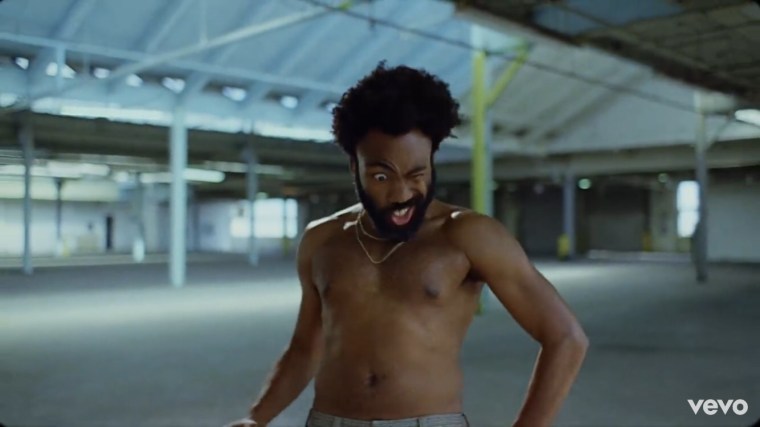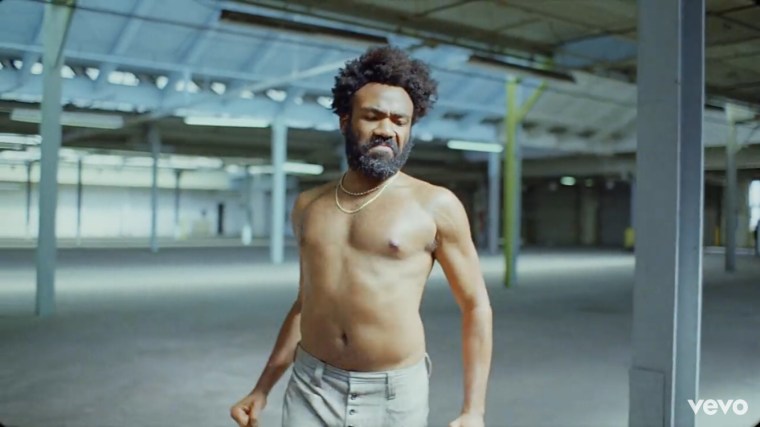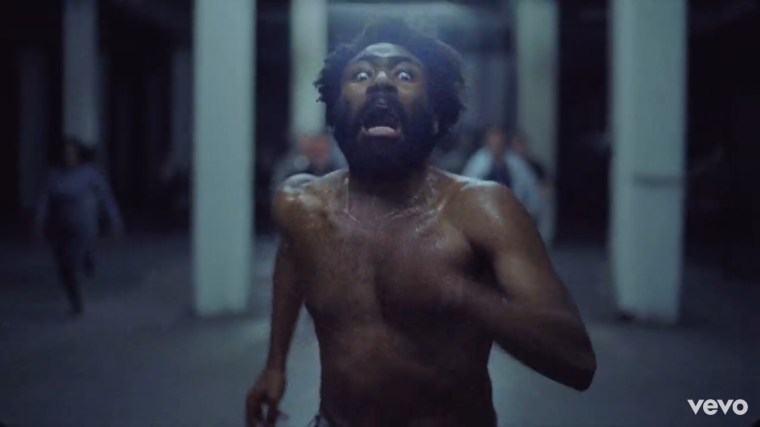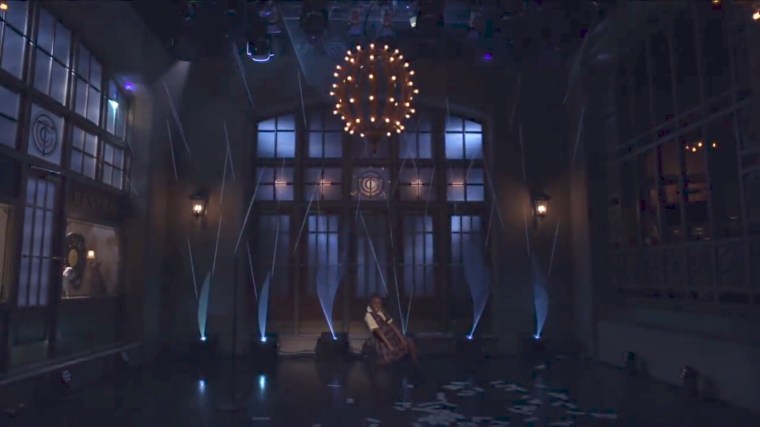A few days ago, Childish Gambino’s “This is America” dropped. Since then, people have been talking about the song and the video, either praising or questioning Gambino and Hiro Muria’s message and delivery. Initially, I landed on the side of utter praise for the song and the video. I’ve been a fan of Donald Glover since Community and of his music since Camp. With that said, I struggled with what he was trying to do with Camp, and at moments, I find myself utterly frustrated with the misogynistic language and images he deploys on that album. Even though I know that he is constructing an identity and at the same time deconstructing it with the music videos (see “Bonfire” for example), the way he goes about it can be extremely detrimental to fans not attuned to the image he constructs and his means of tearing that image down at various points.
This is the same issue that arose for me with “This is America.” I woke up Sunday morning to see that the video debuted and countless people on my social media feeds were praising it with phrases like “Wow!” I watched the video and immediately followed suit with my own “Wow!” post. However, the more I looked at what people were saying on my feed, the more I started to see another side, a side that we need to think about.
Some of the people on my feed questioned Gambino and Muria’s inclusion of images depicting the deaths of Blacks on screen at the hands of another Black man (Gambino). Specifically, they brought up the scene where he guns down the choir. This scene, of course, is a reference to the Charleston Nine. Individuals on my feed brought up the traumatic effects of this scene and the seeming gratuitous nature of it. Once I started to think about the video even more, I totally agree. Why did this scene need to appear in the video? Why not reverse the script and have Gambino shoot white choir members? Why do Black men and women have to die in the video, not whites? These are questions that I think are important.
I do not claim to have an answer to these questions, but I do think I have something that connects them to what I perceive to be a broader theme in the video and Gambino’s work since Camp. Particularly, I see “This is America” as a commentary on the construction of identity to survive and the ways that society treats Black and Brown individuals as disposable and inconsequential. He has done this since Camp in songs such as “Backpackers” where he raps, “Change my ID for the cops, it’s not enough yet/ Black male in short shorts, I’m double suspect.” Here, he comments on using the stage persona Childish Gambino and keeping that separate from Donald Glover. As well, he points to the ways that white society views him as suspect because he is a Black male and the ways that some in the African American community may view him as suspect because of his attire. Thus, he straddles two worlds. 
Even with the straddling, the white world views him, unless he panders to what they want, as suspect and nothing more than an entertainer. The first 50 seconds of the song, and the video, give off a carefree vibe with catchy vocals and Gambino dancing for the camera. During this section, Gambino essentially mugs for the camera. In this moment, he is playing into society’s view of a Black entertainer. His varying facial expressions emit bravado and braggadocio as his dance moves exude sensuality.

All of this construction, though, comes to an abrupt end when he approaches a now hooded Black guitar player seated in a chair, pulls a gun from his waistband, and shoots the Black man in the back of the head execution style. Abruptly, the music changes, and Gambino moves from the upbeat “We just wanna party/ party just for you” to the ominous “This is America/ Don’t catch ya slippin’ up.” This move, both lyrically and musically signals the undercurrent apparent in the song.
When white society sees Gambino, or other Black entertainers, “slippin’ up,” they’ll turn on him and bring him down. However, as long as he does nothing more than “shut up and dribble,” as Laura Ingraham suggested to LeBron James, Gambino will be fine. He’ll make his money, get his girls, and live the life of luxury. Upon my initial viewing, I saw the choir scene as part of this. There, as with the first execution, Gambino gets away. No one chases after him. In fact, after he murders the choir, the police all run past him as he goes back to the middle of the warehouse where him and the others dance dance with smiles on their faces as he raps, “I’m so pretty.”
This move makes me think about the ways that the police treat suspects. They arrested Dylan Roofe and Travis Reinking after they each massacred individuals. However, they murder Stephon Clark and Alton Sterling for nothing more than being Black. If we think about Gambino straddling identities, then can we see Gambino working with these constructions? I’m not sure about this, but it is something I have thought about. He has rapped about being in between two worlds and identities. On “Firefly” he states, “I used to get called Oreo.” In the same song, he also comments on being the only Black kid at a Sufjan Stevens concert.
The reality, though, is that if Gambino actually shot the man at the beginning of the video or the choir then the police would probably no take him “peacefully.” He would probably not even make it to the courthouse. He would probably either be in the morgue or in the hospital recovering from wounds from the apprehension. Gambino’s Blackness, not matter how else he constructs his identity, makes him a threat. He knows this, and “This is America” addresses that fact in full view of the world.
This becomes abundantly clear near the end of the video when he raises his hands as if holding a gun (a Tamir Rice reference?) and then pulls a joint out of his pants and lights it. No one confronts him, but the imagery is telling. Immediately following this, he jumps on top of a car and dances in a scene that recalls the end of Michael Jackson’s “Black or White,” another link that needs to be talked about considering the recent Atlanta episode “Teddy Perkins.”
 To drive this point home even further, the video concludes with a scared Gambino running towards the camera as an indistinguishable white mob runs after him. Gone is the braggadocio. In it’s place, fear. Underneath Gambino’s frightened exit, Young Thug raps,
To drive this point home even further, the video concludes with a scared Gambino running towards the camera as an indistinguishable white mob runs after him. Gone is the braggadocio. In it’s place, fear. Underneath Gambino’s frightened exit, Young Thug raps,
You just a Black man in this world
You just a barcode, ayy
You just a Black man in this world
Drivin’ expensive foreigns, ayy
You just a big dawg, yeah
I kenneled him in the backyard
No probably ain’t life to a dog
For a big dog
Gambino, for all his posturing and “feel good vibes,” exists as nothing more than a commodity and image for consumers. Underneath all of that, he is “just a Black man in this world” and susceptible to the same treatment as other Black individuals. His celebrity doesn’t shield him. His wealth doesn’t shield him. His skin marks him, and unless he remains “kenneled” and smiling, then he will face the consequences of being Black in America.
Sonia Rao in The Washington Post sums it up this way: “[Gambino] keeps the darkness at bay by acting within white-imposed boundaries for most of the video — hence the rich depth of field, with his giddy dancing layered in front of violence — but it eventually catches up with him.”
In conclusion, I do want to reiterate that this video and song are not perfect. I do agree that the choir scene is excessive. What is it’s purpose? Is it just a reference? I think more is there, but I am not totally sure what. Why do we need to revisit these sites of terrorism and violence? I ask these questions for two reasons. One, these images trigger responses in individuals, and those need to be considered. Two, will most audience members, no matter if they agree with the image or not, interrogate the image/message? Or, will they just say, “Wow!” Both of these reasons give me pause when thinking about that scene.

Before I end, I want to note the conclusion of his SNL performance of this song. There, we see the same dancers dressed up in what appear to be school uniforms. They are dressed nicely, dance, and smile as Gambino raps. One of them is younger; I cannot tell her age. The song ends with her dancing alone on stage as the final lines fade out. She is the impressionable youth, the one that looks up to the entertainer. What does she see? Does she see the entertainer putting on a show to please the audience? Does she see the entertainer continuing on as if everything is ok while violence and terrorism against Black and Brown bodies exist around him or her? These are some of the questions that arise both from the video and from the SNL performance.
Seriously, there is a lot more to say here, but I do not have the space. What are your thoughts? As usual, let me know in the comments below, and make sure to follow me on Twitter at @silaslapham.
Great post! English teacher here.
I did see the Charleston 9 connection with the choir but the number of singers (10) threw me off a bit. It may be a minor thing but I took it as significant – maybe that scene is referencing the rhetoric that, like black entertainers, the “black church” is happy with singing and clapping and positivity, blind to the societal issues in their midst. In the video, Glover literally stops their singing with gunshots and declares “This is America.”
More questions: Is this moment his proverbial wake-up call for African Americans? Is he saying “they will still kill you even if you pray, sing and smile”? Is Gambino the shooter because he is the main focus of the video and acting a proxy Dylan Roof? Have the forms of artistic expression, which flourished during oppression, blinded us to the actual problems that exist within our community?
LikeLike
Those are some great questions. I tend to think, overall, he is working within the context that entertainment and the media has “blinded us” to reality. I see him doing this since “Camp.” I still don’t know what to make of him serving as proxy for Roof. That ones leaves my head scratching.
LikeLiked by 1 person